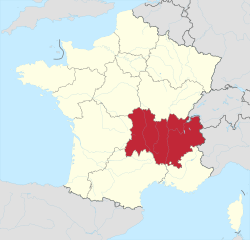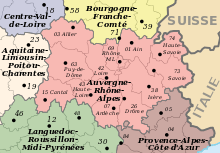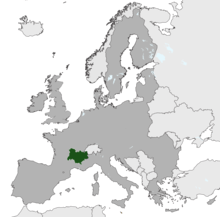Auvergne-Rhône-Alpes
Auvergne-Rhône-Alpes (ARA; French: [ovɛʁɲ ʁon‿alp] (![]()
Auvergne-Rhône-Alpes | |
|---|---|
.jpg) Lake Annecy in the French Alps | |
 Flag  Coat of arms | |
 | |
| Country | |
| Prefecture | Lyon[1] |
| Departments | |
| Government | |
| • President of the Regional Council | Laurent Wauquiez |
| • Prefect | Pascal Mailhos |
| Area | |
| • Total | 69,711 km2 (26,916 sq mi) |
| Area rank | 4th |
| Population (2015) | |
| • Total | 7,877,698 |
| • Density | 110/km2 (290/sq mi) |
| Demonym(s) | Auvergnat / Rhônalpine Aurhalphine (rare & non-official) |
| Time zone | UTC+01:00 (CET) |
| • Summer (DST) | UTC+02:00 (CEST) |
| ISO 3166 code | FR-ARA |
| GDP () | Ranked |
| Total | $270 billion (US$ bn) |
| Per capita | $33,130 (US$) |
| Website | auvergnerhonealpes |
The region covers an area of more than 69,711 km2 (26,916 sq mi), making it the third largest in metropolitan France, and has a population of 7,877,698, second only to Île-de-France.[3] It consists of 12 departments and one territorial collectivity. Lyon is the chef-lieu of the region.
This new region combines diverse geographical, sociological, economic, and cultural regions, which was already true of Rhône-Alpes, as well as Auvergne, to a lesser extent. While the old Rhône-Alpes and Auvergne regions each enjoyed a unity defined by axes of communication and the pull of their respective metropoles,[Note 1] the new combination is heterogeneous, and sustained lively opposition from some local officials after its creation.[4][5][6][7]
Toponymy, logo, and symbols
The text of the territorial reform law gives interim names for most of the merged regions, combining the names of their constituent regions alphabetically, separated by hyphens. Permanent names would be proposed by the new regional councils and confirmed by the Conseil d'État by 1 October 2016.[8][9]
The interim name of the new administrative region was a hyphenated placename, composed of the historic region of Auvergne, the river Rhône, and the French Alps (Alpes). The same name has been chosen as the definitive name, which was officialized by the Conseil d'État on 28 September 2016.[10]
According to several online polls from Lyon Capitale, the name "Rhône-Alpes-Auvergne" led voting, ahead of "Alpes-Auvergne" and "AURA" (an acronym for Auvergne-Rhône-Alpes)[11], which was proposed by Jean-Jack Queyranne, the former president for the former Rhône-Alpes region. Schoolchildren were consulted about the name of the new region in February 2016, and local residents were consulted in March.[12]
After adjusting the votes in proportion to the number of inhabitants of the regions (Rhône-Alpes having five times the population of Auvergne) the name "Rhône-Alpes-Auvergne" was still leading, ahead of "Auvergne-Rhône-Alpes" and the acronym "AURA".[13]
Despite this result, Laurent Wauquiez and his team decided not to follow the preference of the citizens of the new region, and the name Auvergne-Rhône-Alpes was put to the vote by the regional assembly and adopted unanimously on 23 June 2016;[14][15] it was made official on 28 September 2016 through a decree appearing in the Journal officiel de la République française.[1]
The region was given a coat of arms in October 2017, which combined those of Auvergne, Savoie, Lyonnais and Dauphiné[16] It also has a flag, which initially consisted of the coat of arms on a white background, but was replaced by a heraldic flag in January 2018. On 9 February 2018, the region formalized the flag and the coat of arms on its website, as implemented by Mattieu Casali, a historical scholar.[17] It was received favourably by the national heraldic commission[18]
The blazon given on the region's website is Écartelé : au premier d’or au gonfanon de gueules bordé de sinople (Auvergne) ; au deuxième de gueules à la croix d’argent (Savoie) ; au troisième de gueules au lion d’argent (Lyonnais) ; au quatrième d’or au dauphin d’azur, crêté, barbé, loré, peautré et oreillé de gueules (Dauphiné)., which translates roughly to: Quarterly: 1st Or a gonfalon Gules bordered Vert (Auverne); 2nd Gules a cross argent (Savoie); 3rd Gules a lion argent (Lyonnais); 4th Or a dolphin Azure, crested, bearded, lored, and oreilled Gules.[17]
 Official coat of arms, released in 2017 and officialized in 2018.
Official coat of arms, released in 2017 and officialized in 2018..svg.png) First flag, which appeared at the same time as the coat of arms.
First flag, which appeared at the same time as the coat of arms. Flag officialized in 2018
Flag officialized in 2018
In Francoprovençal and in Occitan, two of the three languages that are historically spoken in the region, the name is pronounced:[Note 2]:
- Arpitan (francoprovençal): Ôvèrgne-Rôno-Arpes [o.ˌvɛr.ɲə.rɔn.ˈar.pə] ;
- Occitan : Auvèrnha-Ròse-Aups [ɔwˈver.ɲə.rɔz(e).ɔwp].
Geography
Location

The Auvergne-Rhône-Alpes administrative region covers an area of 69 711 km2 in the centre and east of the south of France. It is a collection of regions of diverse topographies, climates, natural resources, cultures, folklore, architecture, and languages. It is bordered by five other administrative regions: Bourgogne-Franche-Comté to the north, Centre-Val de Loire to the northeast, Nouvelle-Aquitaine to the west, Occitanie to the south-west, and Provence-Alpes-Côte d'Azur to the south-east. It is also bordered by Italy (Aosta Valley and Piedmont) to the east and Switzerland (Cantons of Geneva, Valais, and Vaud) to the north-east.

Extreme points:
- North: Château-sur-Allier, Allier (46.804272°N 2.959629°E)
- East: Bonneval-sur-Arc, Savoie (45.403287°N 7.185578°E)
- South: Ferrassières, Drôme (44.115494°N 5.494467°E)
- West: Siran, Cantal (44.976621°N 2.062885°E)
Departments
Auvergne-Rhône-Alpes comprises twelve departments: Ain, Allier, Ardèche, Cantal, Drôme, Haute-Loire, Haute-Savoie, Isère, Loire, Puy-de-Dôme, Rhône, Savoie
Metropolitan centers
- Lyon (1,622,331; region prefecture)
- Grenoble (510,368)
- Saint-Étienne (372,308)
- Clermont-Ferrand (264,704)
- Chambéry (186,355)
Important train stations
- Lyon Part-Dieu
- Lyon Perrache
- Valence-Ville
- Valence-TGV
- Saint-Étienne-Châteaucreux
- Grenoble
- Bourg-Saint-Maurice
- Chambéry-Challes-Les-Eaux
- Clermont-Ferrand
Economy
The Gross domestic product (GDP) of the region was 270.0 billion euros in 2018, accounting for 11.5% of French economic output. GDP per capita adjusted for purchasing power was 30,200 euros or 100% of the EU27 average in the same year. The GDP per employee was 109% of the EU average.[19]
Politics
The region is governed by the regional council of Auvergne-Rhône-Alpes consisting of 204 members. The current regional council was elected in regional elections on 6 and 13 December 2015, with the list of Laurent Wauquiez consisting of The Republicans (LR), the Democratic Movement (MoDem), and Union of Democrats and Independents (UDI) securing an absolute majority of 113 seats.[20][21]
.svg.png) | ||||||||
| Leader | List | First round | Second round | Seats | ||||
|---|---|---|---|---|---|---|---|---|
| Votes | % | Votes | % | Seats | % | |||
| Laurent Wauquiez | LR–MoDem–UDI | 795,661 | 31.73 | 1,201,597 | 40.62 | 113 | 55.39 | |
| Christophe Boudot | FN | 639,923 | 25.52 | 667,102 | 22.55 | 34 | 16.67 | |
| Jean-Jack Queyranne | PS–PRG | 600,112 | 23.93 | 1,089,756 | 36.84 | 57 | 27.94 | |
| Jean-Charles Kohlhaas | EELV–PG–ND | 173,038 | 6.90 | |||||
| Cécile Cukierman | PCF | 135,274 | 5.39 | |||||
| Gerbert Rambaud | DLF | 71,538 | 2.85 | |||||
| Éric Lafond | NC | 39,187 | 1.56 | |||||
| Chantal Gomez | LO | 31,359 | 1.25 | |||||
| Alain Fédèle | UPR | 21,723 | 0.87 | |||||
| Total | 2,507,815 | 100.00 | 2,958,455 | 100.00 | 204 | 100.00 | ||
| Valid votes | 2,507,815 | 96.55 | 2,958,455 | 96.58 | ||||
| Blank votes | 59,333 | 2.28 | 59,166 | 1.93 | ||||
| Null votes | 30,175 | 1.16 | 45,577 | 1.49 | ||||
| Turnout | 2,597,323 | 48.91 | 3,063,198 | 57.68 | ||||
| Abstentions | 2,713,316 | 51.09 | 2,247,266 | 42.32 | ||||
| Registered voters | 5,310,639 | 5,310,464 | ||||||
| Source: Ministry of the Interior, Le Monde (parties) | ||||||||
See also
Notes
- With the exception of Haute-Loire which is found in the economic region of Saint-Étienne.
- Auvèrnha or Auvèrnhe in Auvergne and Vivaro-Alpine regions; Ròse as the general Occitan form; Aups in Vivaro-Alpine, Alpas in Auvergnat.
References
- "Décret No. 2016-1266 du 28 septembre 2016 portant fixation du nom et du chef-lieu de la région Auvergne-Rhône-Alpes" (in French). 28 September 2016. Retrieved 3 July 2017..
- "La carte à 13 régions définitivement adoptée" (in French). Le Monde. Agence France-Presse. 17 December 2014. Retrieved 13 January 2015.
- "Insee - Populations légales 2012 - Populations légales 2012 des régions". Insee. Retrieved 16 January 2015.
- Poignard, Frédéric (10 October 2008). "Le Grand Lyon, laboratoire du "big bang territorial"". Le Figaro (in French). Retrieved 4 October 2017.
- "Rapport Balladur : Que pensez-vous de la fusion Auvergne et Rhône-Alpes ?". Cyberbougnat (in French). 25 February 2009. Retrieved 4 October 2017.
- Licourt, Julien (15 January 2014). "La réduction du nombre de régions réveille les susceptibilités locales". Le Figaro (in French). Retrieved 4 October 2017.
- "Observatoire de la FPI : Auvergne-rhône-Alpes" (PDF). fpifrance.fr (in French). January 2016. Archived from the original (PDF) on 2016-10-20. Retrieved 2017-10-04.
- Loi n° 2015-29 du 16 janvier 2015 relative à la délimitation des régions, aux élections régionales et départementales et modifiant le calendrier électoral (in French)
- Bancaud, Delphine (2014-12-18). "Carte de France à 13 régions : Comment vont-elles s'appeler ?". 20 minutes (in French). Retrieved 2017-10-04.
- Décret n° 2016-1266 du 28 septembre 2016 portant fixation du nom et du chef-lieu de la région Auvergne-Rhône-Alpes (in French)
- Steven, Belfils (2014-12-18). "Sondage : quel nom pour la future région ?". lyoncapitale.fr (in French). Retrieved 2017-10-04.
- Fallas, Claude (27 May 2016). "Laurent Wauquiez propose Auvergne-Rhône-Alpes comme nom de la nouvelle Région" (in French). Retrieved 8 March 2017.
- Cerinsek, Patricia (2016-03-14). "La Région Auvergne Rhône-Alpes cherche (toujours) son nom". Place Gre'net (in French). Archived from the original on 2019-04-06. Retrieved 2017-10-04.
- "Le nouveau nom de la région sera Auvergne/Rhône-Alpes". Le Progrès (in French). 27 May 2016. Retrieved 27 May 2016.
- "Les élus de la Région valident le nom Auvergne Rhône-Alpes". lyonmag.com (in French). 23 June 2016. Retrieved 23 June 2016. External link in
|website=(help) - Koller, Rodolphe (2 November 2017). "La Région se dote sans bruit d'un nouveau blason". saladelyonnaise.com (in French). Archived from the original on 7 November 2017. Retrieved 4 November 2017.
- "Un blason qui fait sens pour Auvergne-Rhône-Alpes". auvergnerhonealpes.fr (in French). 9 February 2018. Archived from the original on 10 February 2018. Retrieved 10 February 2018.
- Commission nationale d'héraldique, ed. (2018). Rapport Annuel 2017 des Archives en France (PDF) (in French). p. 41. Retrieved 12 December 2018.
[...] En 2017, la Commission nationale d’héraldique s’est réunie deux fois, les 3 avril et 18 octobre. Elle a examiné 31 dossiers : [...] • 2 blasons de grandes régions : Auvergne-Rhône-Alpes [...] 61 % de ces dossiers ont reçu un avis favorable de conformité héraldique, notamment ceux des grandes régions. [...]
- "Regional GDP per capita ranged from 30% to 263% of the EU average in 2018". Eurostat.
- "Résultats des élections régionales 2015". Ministère de l'Intérieur. 13 December 2015. Retrieved 28 January 2018.
- Pierre Breteau; Samuel Laurent; Maxime Vaudano (5 August 2015). "Elections régionales : quel est le candidat dans votre (nouvelle) région ?". Le Monde. Retrieved 28 January 2018.
External links
| Wikivoyage has a travel guide for Auvergne-Rhône-Alpes. |